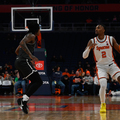Syracuse Horsing Around: University Equestrian Team rides into competition
It’s just above 25 degrees on a Friday morning at Hoyt Training Stables, and the breath of both the Western Syracuse equestrian team riders and the horses they’re saddling is visible. Despite chilly weather, trainer Jen Hoyt, owner of Hoyt Training Stables and the coach of the Syracuse University Western team, barks at Amy Marcello, a senior in the Martin J. Whitman School of Management, to remove her jacket so she can judge her equitation, or position.
Marcello and the rest of the Western SUET riders have been training all year for the regional show, which took place Wednesday night, in which both co-captain Ilana Dubrovsky, a junior policy studies major, and Jackie Anderson, a senior fisheries major, accumulated enough points to secure a spot in the larger zone competition on April 9. The Syracuse Zone riders will ultimately be competing for a chance to show at the national show in late April, an event that will include the best riders from colleges across the country.
The Syracuse team has been competing since fall in a series of local shows against Cazenovia College, Oswego State University of New York and the Rochester Institute of Technology to win championships for the team and to advance as individuals.
The team is consistently reserve champion at shows, said Hoyt, but, Dubrovsky said, ‘We beat Cazenovia last Sunday and ended up champion. They usually beat us, but we’re getting better, and I think it was kind of a wake-up call for them.’
College equestrian teams consist of four levels of riders – beginner, intermediate, novice and advanced – to ensure riders compete against individuals of equal skill and experience. Placing in the top six, or pinning, in a class at a show earns riders individual points, which they accumulate throughout the year in order to advance to a higher level and qualify for the regional, zone and national horse shows.
Syracuse riders train and compete fall through spring in order to gain heightened ease in the saddle and the ability to invisibly execute the skills they learn in practice -everything from leg pressure to hand placement to seat posture. Horsemanship, the most popular class among western SUET members, ‘tests a rider’s ability to manipulate their horse while maintaining excellent equitation,’ Hoyt said. Riders that walk away with championships are those that best demonstrate this ability – and make it completely invisible to the human eye.
The effortless perfection (or at least the appearance of it) required to pin in competition is complicated by the collegiate rule that disallows riders to compete aboard their own horses, or even a horse of their choosing. Unlike non-collegiate horse shows, every competitor is randomly assigned a horse to compete on, and does so without so much as a practice, or schooling, round. The SUET riders can never anticipate what kind of horse they’ll draw, so lessons are conducted on different mounts almost every time.
‘It’s like the ultimate in catch-riding,’ Hoyt said, citing a trade common at non-collegiate shows in which seasoned competitors loan themselves out to horse owners in need of a rider. ‘They literally draw a horse out of a hat, get on, adjust their stirrups and walk into the ring.’
Since competitors are not permitted even a warm-up on their horses, the playing field is level for everyone. In a sport where a lack of knowledge about a horse’s habits, skills and weaknesses usually means a low finish, riders do everything possible to learn about potential mounts well in advance.
Before her class, Dubrovsky intently studies another competitor take her assigned horse though a pattern.
‘I’ve heard he’s a really good draw,’ she says of the good-looking bay quarter horse. ‘But you can never really know for sure,’ she adds with a grin.
‘We’re allowed to watch the horses school before the competitors draw,’ Hoyt said. ‘You try and learn as much as you can about them ahead of time to anticipate what to expect in the ring.’
Both riders from Syracuse qualified for competition at regionals showed in horsemanship. But even though competition is the centerpiece around which all the riders devote their time and practice, the Western equestrian team is about much more than simply competing for ribbons and silver plates. At a school where finding a place can often seem daunting, Debrovsky agrees that being a part of a team, club or group is the best way to make the university seem smaller.
‘It sounds cheesy,’ Devrovsky said, ‘but this team is such a big part of my life here at school, and joining helped me find my niche.’
The flexibility and diversity of the team are its greatest assets, and also those which make the disproportionate ratio between practice and competition worth it. The team currently has about 12 riders and according to the captains, is always looking to recruit new members, regardless of experience or year.
‘You can take it as seriously as you want,’ Debrovsky said. ‘We have riders who have joined without ever having been on a horse before, and then we have members who grew up around horses and compete really seriously. It’s completely up to you.’





